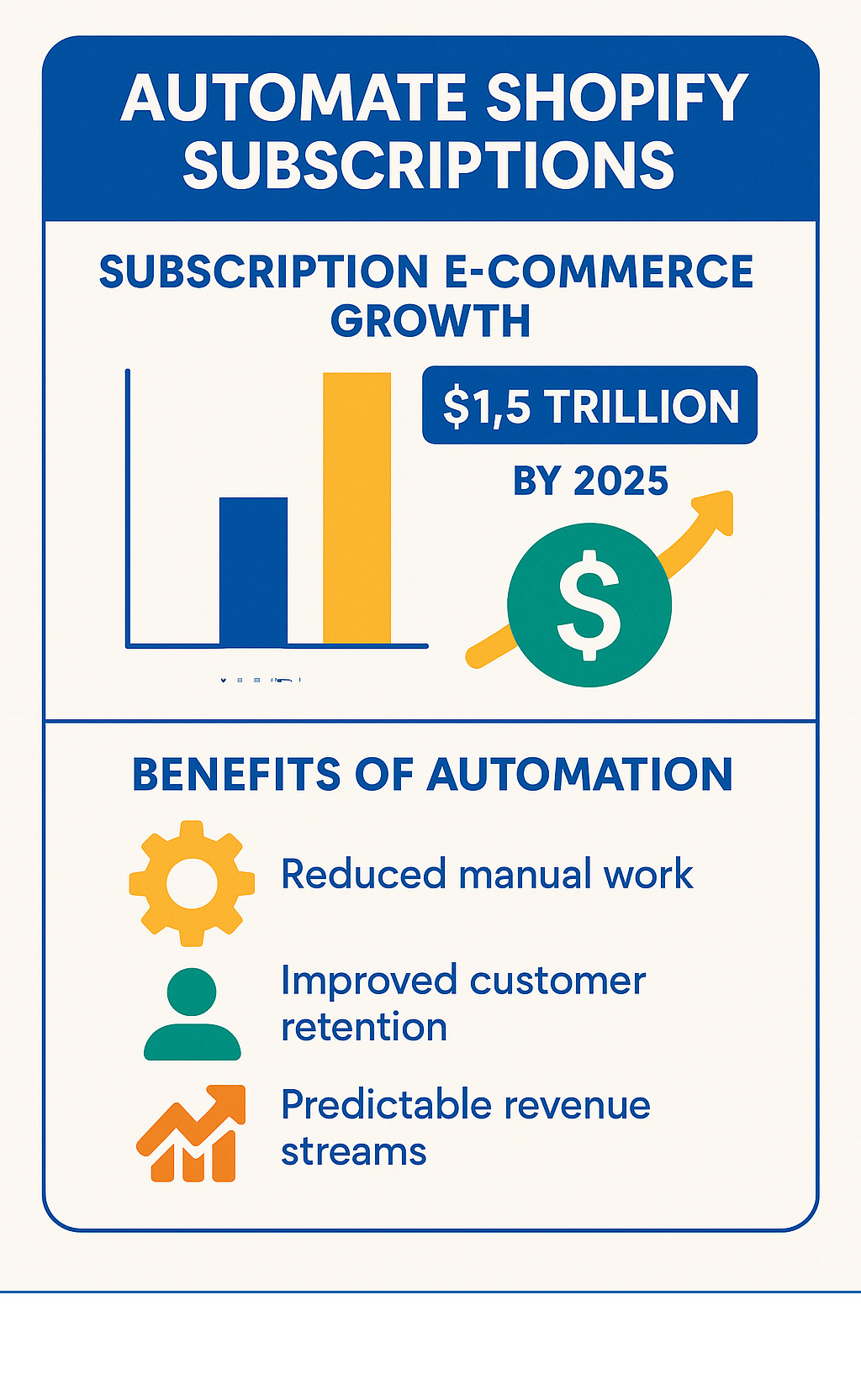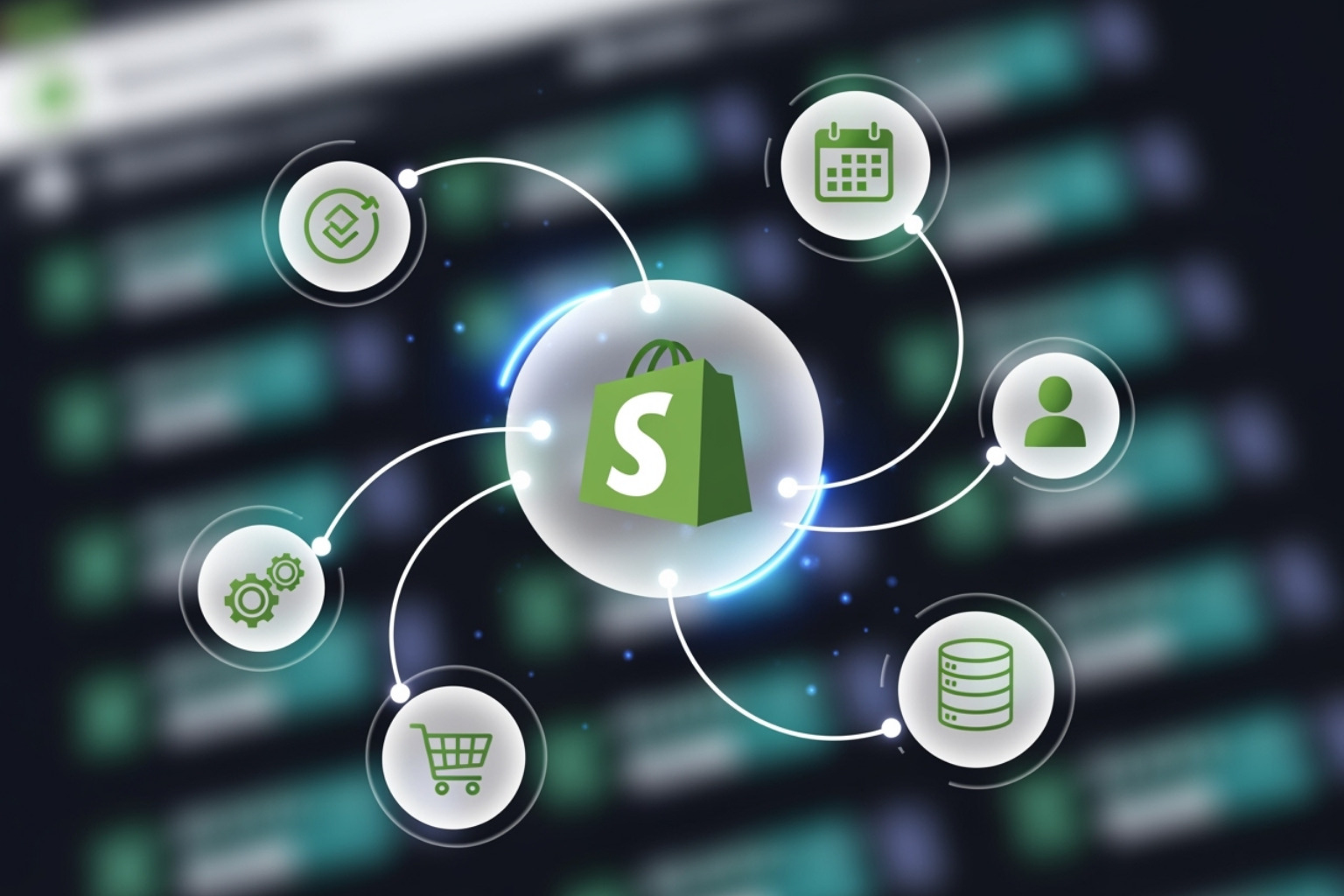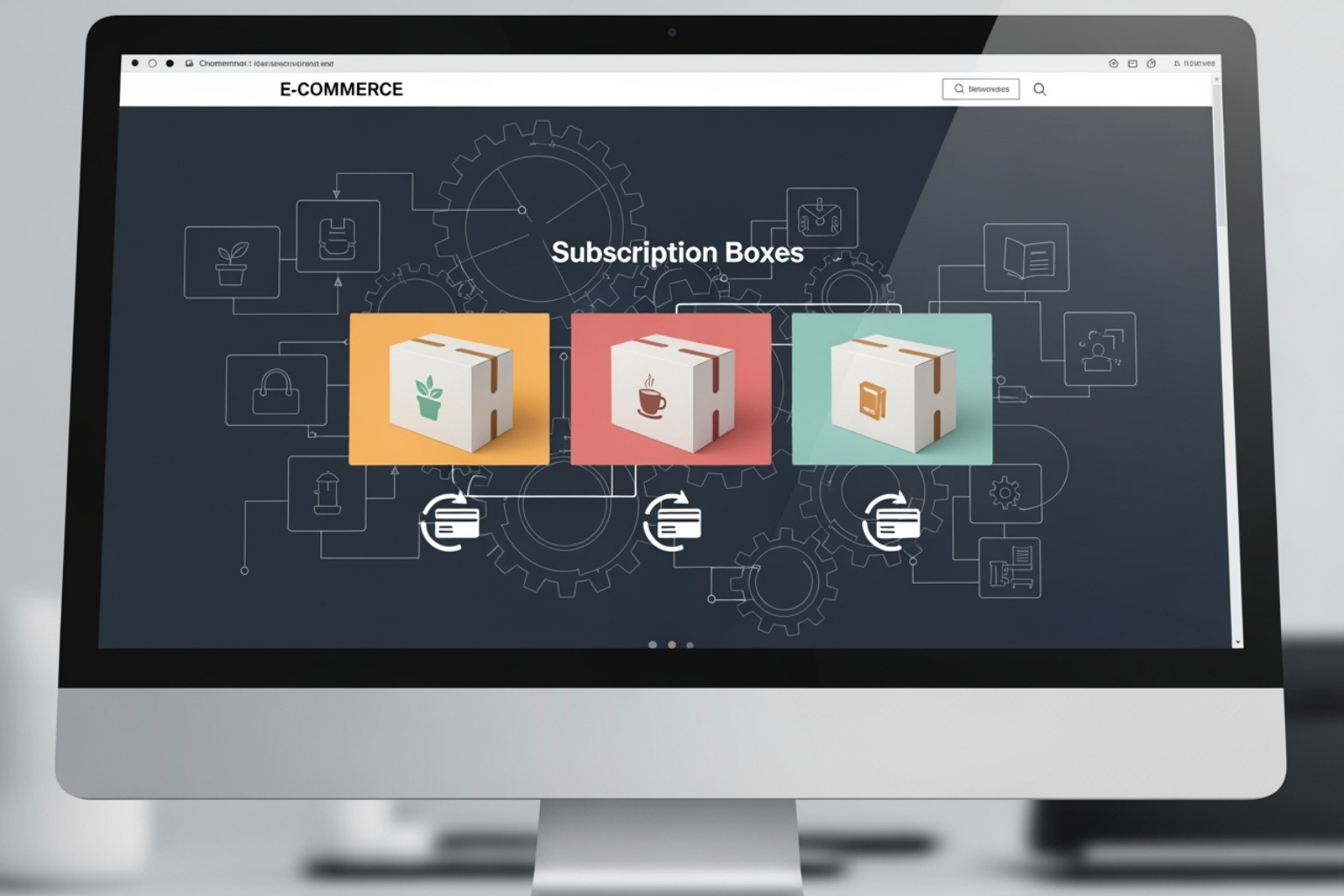Why Subscription Automation is Essential for Shopify Growth
Automate Shopify subscriptions to turn one-time buyers into loyal customers. Here's the basic process:
- Choose a subscription app: Select from Shopify's native app or third-party options.
- Set up plans: Define billing cycles, discounts, and delivery options.
- Integrate with your store: Add subscription widgets and a customer portal.
- Automate billing: Handle recurring payments and failed payment retries automatically.
- Monitor and optimize: Track metrics to reduce churn and improve your offerings.
The subscription market is expected to reach $1.5 trillion by 2025. This model removes the manual work of recurring billing and order processing. Your Shopify store can automatically charge customers and manage subscriptions, freeing you to focus on growth.
Automated subscriptions build predictable revenue, increase customer lifetime value, and lower customer acquisition costs. For some brands, subscriptions can make up 70% of their orders.
I'm Steve Pogson, founder of First Pier. My Shopify Expert Agency has helped brands like Wyman's Blueberries and Tandem Coffee Roasters automate Shopify subscriptions for sustainable growth. With over two decades in e-commerce, I've seen that automation is a key tool for scaling online businesses.

Simple automate shopify subscriptions word guide:
Why Your Shopify Store Needs a Subscription Model
A subscription model can turn one-time buyers into a steady stream of recurring revenue. It's a smart way to think about growth.
Subscriptions boost Customer Lifetime Value (CLV). A customer buying a $30 product monthly becomes worth $360 a year, not just $30. This simple math transforms your bottom line.
This model also improves customer retention and creates predictable recurring revenue, allowing you to forecast income and plan for growth. You can also simplify inventory management by knowing how much stock you'll need each month, preventing over-ordering.
Finally, subscriptions reduce marketing costs. Acquiring new customers is expensive, but retaining them through subscriptions is cost-effective. You can focus on nurturing existing relationships instead of constantly hunting for new sales.
If you're curious about how a subscription strategy could transform your specific business, you can learn more about subscription strategy execution and how we help brands implement these systems.
Common Subscription Models to Consider
There's no one-size-fits-all subscription model. Here are some common approaches:
- The replenishment model is for products customers use regularly, like coffee or vitamins. It offers the convenience of never running out.
- The curation model delivers a selection of products, often based on customer preferences. Birchbox is a classic example, sending new beauty samples monthly.
- The access model grants subscribers special perks, like exclusive content, services, or early access to sales.
- The build-a-box model lets customers choose specific items for their recurring order, giving them control and personalization.
- Membership plans combine access and replenishment, offering discounts, free shipping, or other perks for a recurring fee.
The Benefits of Automating the Process
Managing subscriptions manually is a common mistake that leads to spreadsheets and headaches. You need to automate Shopify subscriptions from the start.
Automation offers key benefits:
- Reduced manual work: The system handles recurring payments and orders automatically, freeing up your team.
- Fewer errors: Automated systems are less prone to billing mistakes or missed renewals.
- Scalability: An automated system can handle thousands of subscribers, something impossible to do manually.
- Better customer experience: Self-service portals let customers manage their own subscriptions (pause, skip, swap products), which improves satisfaction.
- Automated billing and dunning management: The system processes payments on time and automatically handles dunning—the process of recovering failed payments. This prevents losing customers due to simple payment issues.
Properly automated subscriptions save time and build a system that grows with your business while keeping customers happy.
How to Automate Shopify Subscriptions: A Step-by-Step Guide
Setting up automate Shopify subscriptions is straightforward once you understand the framework. Shopify's subscription APIs work with both native and third-party apps to make it happen.

Shopify handles secure payments and order management, while subscription apps add the logic for recurring billing and customer portals. The integration is seamless for your customers at checkout. For custom solutions, you may need expert help, and you can find more info about Shopify development.
Step 1: Choose Your Subscription Tool
Your first decision is choosing a tool. The right choice between Shopify's native app and a third-party solution depends on your needs.
Shopify's native app, Shopify Subscriptions, is a straightforward tool integrated into your admin. It's great for businesses starting with simple replenishment models, offering basic weekly, monthly, or yearly plans.
Third-party apps offer more advanced features for businesses with bigger ambitions. They provide deeper customization, analytics, and customer portal options.
Here's a quick comparison:
| What You're Looking For | Shopify's Built-in App | Third-Party Solutions |
|---|---|---|
| Getting Started Quickly | Perfect - simple setup, immediate integration | May take longer but offers guided onboarding |
| Customization Options | Basic plans and discount options | Advanced rules, custom billing cycles, complex product bundles |
| Customer Experience | Clean, simple portal | Rich portals with product swapping, loyalty rewards, "build-a-box" features |
| Business Intelligence | Basic reporting through Shopify | Advanced analytics, churn prediction, revenue forecasting |
| Support When You Need It | Standard Shopify support | Often dedicated teams, sometimes 24/7 specialized help |
| Migration Assistance | You're mostly on your own | Many offer white-glove migration with zero downtime guarantees |
Advanced third-party features like "Default to Subscribe" options or better dunning management can significantly boost conversion and retention.
Step 2: Setting Up Your Subscription Plans
After picking your tool, create subscription plans that appeal to your customers.

- Delivery frequency: Start with monthly, but consider offering other options like weekly or quarterly to match customer needs.
- Discount strategy: Go beyond a flat discount. Consider progressive discounts for loyalty or subscriber-exclusive products to create a strong value proposition.
- Product configuration: Decide if products will be subscription-only or available for one-time purchase. Make the subscription option the more attractive choice.
For the native app, follow Shopify's guide on setting up subscriptions in Shopify.
Step 3: Integrating with Your Store and Managing Subscriptions
This step makes subscriptions visible to customers and manageable for you.
- Add subscription widgets to product pages: Modern Shopify themes make it easy to add a block showing subscription options, discounts, and frequencies next to the purchase button.
- Customize the customer portal: A good portal is key for satisfaction. It lets customers pause, swap products, or add items to their next order. This self-service reduces support tickets.
- Manage from your admin: You'll see all subscribers in one place, filtered by status. View individual profiles to see their history and upcoming orders.
- Automate payment processing: Shopify securely processes recurring charges on schedule, sends confirmations, and handles receipt generation.
- Handle inventory: For prepaid subscriptions, inventory is reserved at fulfillment time, not at purchase, preventing overselling.
A well-automated system handles these complexities for you. For more details, see Shopify's guide on managing subscriptions in the admin panel.
Key Features to Look for in a Subscription App
Choosing the right subscription app is like picking a business partner. It should work hard for you and make life easy for your customers. Here are the key features to look for:
- Flexible billing cycles: Offer weekly, monthly, or custom intervals to match customer needs.
- Customizable customer portal: This is critical. A good portal lets customers manage their own subscriptions (skip, pause, swap products, update payment info), which reduces your support workload.
- Dunning management: Automatically retries failed payments and notifies customers. This feature is essential for recovering revenue from payment hiccups.
- Analytics and reporting: Track key metrics like churn rate, recurring revenue, and customer lifetime value to make informed decisions.
- Integration capabilities: Ensure the app works with your other tools, like email marketing and tax software.
- Product swapping: Allowing customers to switch products easily can reduce churn.
- Cancellation management: Offer options like pausing a subscription or a special discount to retain customers who are trying to cancel.
- Build-a-box functionality: Lets customers create personalized subscription boxes, which they love.
- Automation and workflows: Automate repetitive tasks like adjusting billing dates or updating prices.
- Integrated payments and user-friendly interfaces: The app should support your payment gateways and be easy for both you and your customers to use.
A great user experience is vital for subscriptions. You can learn more about this at e-commerce UX design. The right app is an investment that saves time and protects revenue.
Overcoming Common Subscription Management Challenges
Even with automation, subscription businesses face common challenges. Knowing what to expect helps you prepare.

Here are some predictable problems:
- Customer churn: This is when subscribers cancel, either intentionally or because a payment fails. It's the biggest challenge.
- Failed payments: Expired cards or forgotten updates can lead to lost revenue and customers if not handled properly.
- Inventory forecasting: Predicting recurring demand is tricky. Mistakes can lead to stockouts or excess inventory.
- Customer support workload: Support requests will change to focus on managing subscriptions, billing, and delivery schedules.
- Technical glitches: Software issues can affect billing or order processing, making responsive support essential.
How to Reduce Churn and Handle Failed Payments
To manage these challenges, be proactive. Here’s how to reduce churn and handle failed payments:
- Proactive communication: Send friendly reminders for renewals and notifications for failed payments. Keeping customers informed prevents small issues from becoming big problems.
- Dunning management automation: Set up automated retries for failed payments over several days and send polite emails asking customers to update their payment info.
- Flexible options: Let customers skip a delivery, pause their subscription, or swap products. These alternatives to canceling can solve the customer's immediate problem and retain them long-term.
- Loyalty rewards: Surprise long-term subscribers with a bonus item or discount to build an emotional connection and reward their loyalty.
- Exit surveys: If a customer cancels, use a short survey to ask why. This feedback is invaluable for improving your service.
Best Practices to automate Shopify subscriptions for Growth
Growing your subscription business means making your offers attractive and valuable.
- Offer tiered discounts: Reward longer commitments with bigger discounts (e.g., 10% off for 6 months, 20% for a year) to improve retention.
- Promote subscriptions everywhere: Highlight subscription benefits in your email campaigns, social media, and ads, not just on product pages.
- Use analytics to improve: Constantly review data on popular frequencies, CLV, and churn to guide your decisions. If many customers skip monthly deliveries, consider a bi-monthly option.
- A/B test your offers: Regularly test different discounts, frequencies, and messaging to find what works best.
A smooth customer experience is your best tool for growth. For more on marketing, explore more info about e-mail & SMS marketing.
Frequently Asked Questions about Shopify Subscription Automation
When I work with clients who want to automate Shopify subscriptions, I hear the same questions time and again. Let me share the most common concerns and what I've learned from helping dozens of businesses make the transition.
What are the best types of products for a subscription model?
The best products for subscriptions are those that customers need or want regularly. Here are the main categories:
- Consumables: Items that run out, like coffee, vitamins, or pet food. These are a natural fit for replenishment.
- Personal care items: Products like razors, skincare, and cosmetics that are part of a daily routine.
- Curated boxes: A selection of items like snacks or fashion accessories that offer the excitement of a monthly surprise.
- Digital access or memberships: Ongoing value from exclusive content, online courses, or community access.
If your product solves a recurring need or provides regular value, it's likely a good candidate for a subscription model.
How do I move my existing subscribers to a new Shopify app?
Migrating subscribers to a new app is much smoother than it used to be. Here are the common methods:
- White-glove migration services: Many premium apps offer this service, where their team handles the entire transfer for you. This is the easiest and safest option.
- CSV import/export: For smaller lists, you can export data from your old system and import it into the new one using a CSV file. Most apps provide templates to help.
- App developer support: Don't hesitate to contact the app's support team. They have experience with migrations and can provide step-by-step guidance.
The key is correct data mapping to ensure all customer and payment information transfers properly. The goal is a zero downtime migration so your customers' experience is uninterrupted.
How are shipping and taxes handled for recurring orders?
Getting shipping and taxes right is crucial for profitability and customer satisfaction.
- Shipping: It's common to have separate shipping rules for initial vs. recurring orders. While the first order might have multiple shipping options, recurring orders often default to the cheapest rate to keep costs predictable.
- Taxes: Manual tax calculation doesn't scale. Use tax automation tools. Good subscription apps integrate with services like Avalara to automatically calculate sales tax based on customer location and product type. This handles complex tax rules and ensures compliance, giving you peace of mind.
To Sum Up: Start Building Your Recurring Revenue Stream
Building a subscription business is about creating a system that generates predictable revenue. The effort to turn one-time buyers into loyal subscribers is worth it.
The key is automation. When you automate Shopify subscriptions, you build a scalable foundation for growth. Automation handles billing and communications, freeing you to focus on your business and customers.
Beyond automation, focus on the customer experience. Give subscribers flexible options like pausing or swapping products. A helpful customer portal that puts them in control is essential for retention. They are trusting you to deliver value, which is an opportunity to build lasting relationships.
At First Pier, we've seen how powerful this can be. We help brands move from manual processes to smooth, profitable recurring revenue streams. The result is less stress, predictable income, and happier customers.
If you're ready to automate Shopify subscriptions, we can help build a system for your specific needs. We don't use one-size-fits-all solutions.
Let's explore how we can help you grow. Check out our Shopify automation strategy services to get started.







